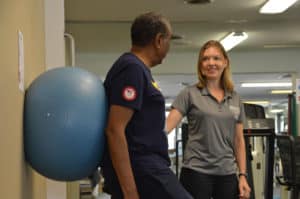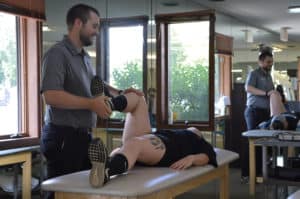 The stronger and more balanced your muscles are before orthopedic surgery (e.g., joint replacement surgery), the stronger and better off you’ll be after.
The stronger and more balanced your muscles are before orthopedic surgery (e.g., joint replacement surgery), the stronger and better off you’ll be after.
That’s the philosophy behind prehabilitation, says physical therapist Joseph Trimarchi of Albany Chiropractic & Physical Therapy.
“The goal of prehabilitation is to improve a patient’s strength and functional capacity prior to surgery through a comprehensive exercise program,” Trimarchi said. “This not only prepares the body for the stresses of the surgery itself, but it better prepares the patient for post-operative rehab, helping lead to a more rapid and successful recovery.”
Researchers have supported this claim. A study published in the October 2014 edition of the Journal of Bone & Joint Surgery determined that physical therapy before joint replacement surgery – a prehabilitation program – can reduce the need for post-operative care by nearly 30 percent.
The American Academy of Orthopedic Surgeons (AAOS) states that about 700,000 total knee replacement and 300,000 total hip replacement surgeries are performed each year in the U.S.
“When a person has reached the point where they need joint replacement surgery, their body’s become accustomed to compensating for pain and certain impairments,” Trimarchi said. “They’ve developed some bad movement habits, leading to weaknesses and the lack of flexibility in areas of the body that are going to need to be strong and flexible during recovery. We can address these weaknesses during prehabilitation.”
A typical prehabilitation program includes warm-ups, cardiovascular exercise, resistance training, and an emphasis on flexibility and practicing functional tasks.
The goal is to improve strength, mechanics, body awareness and overall fitness level.
 Additionally, prehabilitation provides physical therapists with an opportunity to prepare patients for the mental aspect of post-operative rehab, educating them about what to expect immediately after surgery and coaching them on exercises they will need to know during postoperative rehabilitation.
Additionally, prehabilitation provides physical therapists with an opportunity to prepare patients for the mental aspect of post-operative rehab, educating them about what to expect immediately after surgery and coaching them on exercises they will need to know during postoperative rehabilitation.
“Patients often approach the unknown journey toward surgery and post-surgery with a level of anxiety, which is certainly understandable,” said Trimarchi. “Fortunately, educating patients is one of our strengths as physical therapists, and knowledge helps ease some of this anxiety.”
Trimarchi says that in order to optimize its benefits, prehabilitation should begin at least six weeks prior to surgery. To learn more about the benefits of prehabilitation, those facing the potential for joint replacement should consult their physicians as well as their physical therapist.
